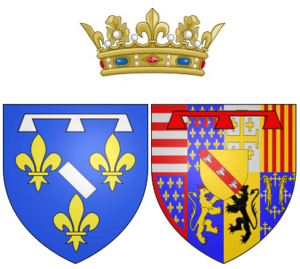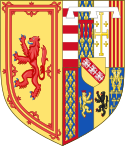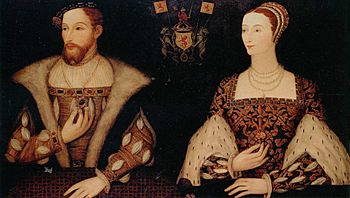Mary of Guise facts for kids
Mary of Guise (born 22 November 1515, died 11 June 1560) was a powerful French noblewoman. She became the Queen of Scotland in 1538 when she married King James V. Mary was also known as Mary of Lorraine. Her family, the House of Guise, was one of the most important families in France. Mary of Guise was the mother of Mary, Queen of Scots. She played a very important role in Scotland's history, especially during a time of big political and religious changes. She ruled Scotland as Queen Regent for her young daughter from 1554 until her death in 1560.
Mary was the oldest of twelve children born to Claude, Duke of Guise, and Antoinette of Bourbon. In 1534, she married Louis II d'Orléans, Duke of Longueville. This marriage was arranged by the King of France, Francis I. Sadly, Louis died in 1537, leaving Mary a widow at 21. Both King Henry VIII of England and King James V of Scotland wanted to marry her. After much convincing from King Francis I and James V, Mary agreed to marry the Scottish king. They married in June 1538 at St Andrews Cathedral. Mary was crowned queen on 22 February 1540. She had three children with James V: James, Robert, and Mary. Both sons died in April 1541, very close together. When King James V died in December 1542, his only surviving child, Mary, became Queen of Scots when she was just six days old.
After James V's death, Mary of Guise became very important in Scottish politics as the mother of the baby queen. The government was first led by James Hamilton, the Earl of Arran, as regent. This period included a conflict with England called the "Rough Wooing." In 1548, Mary, Queen of Scots, was promised in marriage to Francis, the future King of France, and was sent to France to grow up. Mary of Guise took over as regent in 1554. Her main goal was to protect her daughter's future, keep the alliance between Scotland and France strong, and make the Scottish crown powerful. During her time as regent, Mary was quite accepting of the new Protestant religion, trying to get along with her Protestant subjects. However, she could not stop the big changes of the Scottish Reformation.
Quick facts for kids Mary of Guise |
|
|---|---|

Portrait attributed to Corneille de Lyon, c. 1537
|
|
| Queen consort of Scotland | |
| Tenure | 9 May 1538 – 14 December 1542 |
| Coronation | 22 February 1540 |
| Queen regent of Scotland | |
| Regency | 12 April 1554 – 11 June 1560 |
| Monarch | Mary |
| Born | 22 November 1515 Château des ducs de Bar, Bar-le-Duc, Duchy of Lorraine, Holy Roman Empire |
| Died | 11 June 1560 (aged 44) Edinburgh Castle, Edinburgh, Scotland |
| Burial | July 1561 Saint-Pierre-les-Dames, Reims, France |
| Spouse |
Louis II, Duke of Longueville
(m. 1534; died 1537) |
| Issue more... |
|
| House | Guise |
| Father | Claude, Duke of Guise |
| Mother | Antoinette de Bourbon |
| Religion | Roman Catholicism |
Contents
- Mary's Early Life and Family
- Becoming Duchess of Longueville
- Queen of Scotland
- Mary's Home in Scotland
- Arran's Time as Regent
- Trips to France and England
- Mary Becomes Regent of Scotland
- Trouble with Protestants
- Mary's Death
- Mary's Household
- Mary's Legacy
- Mary in Stories and Films
- Images for kids
- See also
Mary's Early Life and Family
Mary was born in Bar-le-Duc, Lorraine, which is now part of France. She was the oldest daughter of Claude, Duke of Guise, and Antoinette of Bourbon. Her family, the House of Guise, was very powerful. She had many siblings, including Francis, Duke of Guise, and Charles, Cardinal of Lorraine.
When Mary was five, she became a godmother to her younger sister. Soon after, she went to live with her grandmother in a convent. Mary grew to be very tall for her time, about 5 feet 11 inches (1.80 meters). Her mother noted that she often caught bad colds. Around age 14, her uncle and aunt visited her. They were impressed by her and took her from the convent to prepare her for life at the French royal court. In 1531, Mary made her first public appearance at the wedding of King Francis I of France. She became friends with the king's daughters, Madeleine and Margaret. Madeleine later became Queen of Scots before Mary.
Becoming Duchess of Longueville
On 4 August 1534, at 18 years old, Mary married Louis II d'Orléans, Duke of Longueville. Their wedding took place at the Louvre Palace. Their marriage was happy but short. On 30 October 1535, Mary gave birth to their first son, Francis. Sadly, Louis died on 9 June 1537, leaving Mary a pregnant widow at 21. Mary kept Louis's last letter, which mentioned his illness. This letter can still be seen at the National Library of Scotland. On 4 August 1537, Mary gave birth to their second son, named Louis after his father. This baby Louis died very young. Her first son, Francis, wrote letters to his mother in Scotland. In 1545, he sent her a piece of string to show how tall he was. The next year, he sent her his portrait.
Queen of Scotland

In 1537, Mary became a key person in marriage talks with King James V of Scotland. James had lost his first wife, Madeleine of Valois, and wanted another French bride. This was to strengthen Scotland's alliance with France against England. James V had met Mary before and liked her.
King Henry VIII of England, who had recently lost his wife, also wanted to marry Mary. He hoped to stop the French-Scottish alliance. However, Mary refused Henry's offer. She famously said, "I may be a tall woman, but I have a very small neck." This was a clever and dark joke, referring to Henry VIII having executed his second wife, Anne Boleyn, who had a "little neck."
King Francis I of France preferred James's proposal over Henry's. He told Mary's father his wishes. Francis arranged a marriage contract that gave James a large dowry, as if Mary were a French princess. Mary was shocked and worried. She did not want to leave her family and country, especially after losing her husband and young son. James V wrote her a personal letter, asking for her hand and advice. This letter might have helped convince her.
Cardinal David Beaton traveled to France for the marriage talks. He wrote to James V that Mary was "strong, well complexioned, and fit to travel." Mary's family was eager for the marriage to happen quickly. The marriage contract was finalized in January 1538. James V received a dowry of 150,000 French livres. The contract also stated that if James died first, Mary would keep several castles and lands in Scotland for her lifetime.
Mary finally accepted the offer and quickly prepared to leave. A proxy wedding, where someone stands in for the groom, was held on 9 May 1538 in France. About 2,000 Scottish lords traveled to France to attend. Lord Maxwell stood in for James V. Mary sailed from Le Havre on 10 June 1538, leaving her three-year-old son, Francis, behind. She arrived in Scotland six days later at Crail in Fife. King James formally welcomed her at St Andrews with celebrations. James and Mary married in person at St Andrews Cathedral on 18 June 1538. James's mother, Margaret Tudor, wrote that Mary seemed like a "wise Princess." In August, Mary went hunting in the Highlands with James.
Mary's French masons, miners, and an armourer came to Scotland. She also had a French painter, Pierre Quesnel, to decorate her palaces. Her household included a dwarf and a jester, both dressed in green. On 24 August 1539, Mary and James V went on a pilgrimage to the Isle of May. They hoped a visit to the shrine there would help Mary become pregnant.
She was crowned queen at Holyrood Abbey on 22 February 1540. A new crown was made for her from Scottish gold. There were tapestries, church furnishings, and stages for the ceremony. A salute of 30 guns was fired from Edinburgh Castle, and there were fireworks.
James and Mary had two sons: James (born May 1540) and Robert (born April 1541). Sadly, both sons died within 14 hours of each other in April 1541. Mary's mother wrote that the couple was young and should hope for more children. She thought a change of wet nurse and over-feeding might have caused the deaths. The third and last child of their marriage was a daughter, Mary, born on 8 December 1542. This Mary became Mary, Queen of Scots.
Mary's Home in Scotland
Instead of living in Edinburgh, Mary mostly lived in Leith, where French soldiers were stationed. She had two houses in Leith. One was near the Shore, on a street named Queen Street in her honor. This beautiful building was torn down in 1849. She also had a small palace on Rotten Row, now called Water Street. After her death, her daughter Mary, Queen of Scots, visited this house in 1561. This house was also torn down in 1830.
Arran's Time as Regent
After King James V died in 1542, James Hamilton, the Earl of Arran, became the regent of Scotland. King Henry VIII of England wanted the baby Queen Mary to marry his son, Prince Edward. This led to arguments in Scotland between those who supported the English marriage and those who wanted to stay allied with France. It also led to an English invasion, known as the "Rough Wooing." Mary of Guise told an English diplomat that Regent Arran was a "simple man" and she could easily figure out his plans.
Mary of Guise first stayed at Linlithgow Palace. The English diplomat Ralph Sadler visited her in March 1543 to see the baby Queen Mary. Mary of Guise showed him the baby to prove she was healthy, because Arran had spread rumors that the child was sick. Sadler wrote that the baby was "as goodly a child I have seen, and like to live."
In July 1543, Mary of Guise moved with the baby Queen Mary to Stirling Castle. She told Ralph Sadler that the English marriage would happen when Mary was ten years old. She said she was happy at Stirling Castle and praised the house.
Henry VIII soon realized that Mary and Edward would not marry, despite earlier promises. So, in late 1543, he started the war called the Rough Wooing. In 1544, Mary of Guise tried to replace Arran as regent, but she was not successful.
After a Scottish defeat in 1547, French military help weakened England's power and increased Mary of Guise's influence. In July 1548, Mary went to watch the siege of Haddington. Her group came too close to the English guns, and sixteen people around her were killed. After this scary event, Mary gave one of her gunners a reward.
The Scottish Parliament decided on 7 July that the child Queen Mary should be sent to France. She went in August 1548 to be raised with her future husband, Francis, the son of King Henry II of France.
Peace talks began, and Scotland was included in the Treaty of Boulogne in 1550. As part of the treaty, Mary's brother Claude was one of six French hostages sent to England. After her father died, Claude was allowed to come to Scotland. After the treaty, Mary could travel to France to see her family.
Trips to France and England
Mary left Scotland on 6 September 1550. She arrived in Dieppe, France, and joined the French court for a festival in Rouen on 1 October 1550. In Rouen, Mary and the Queen of Scots rode in a parade behind soldiers carrying flags showing Scottish castles that the French had recently defended. Mary brought many Scottish gentlemen with her. Historians believe this trip was a way for Mary to build a strong team.
She stayed with the French court over the winter and then visited several cities in the summer. In April, Mary was worried by news of a plot to poison the young Queen of Scots. A Scottish man who tried to poison her was found in London and sent to the French in May. During her time in France, Mary wanted to get the best marriage deal for her daughter and financial support for herself in Scotland. An English observer noted that Mary was "an importunate beggar" for money.
While traveling with her to Dieppe for her return trip, her son Francis died in Amiens. In October 1551, she met King Edward VI in England. Mary landed at Portsmouth and was escorted to London. She stayed at several places, including Hampton Court. At Whitehall Palace, Edward gave her a diamond ring. The ring had belonged to Catherine Parr, Henry VIII's last wife. Princess Elizabeth was there, but Princess Mary Tudor refused to attend.
On her way back to Scotland, Mary stopped at several houses. Many Scottish nobles were called to meet her at Our Lady Kirk of Steill. Cannons were brought from Leith to Edinburgh Castle to fire salutes when she returned.
Mary Becomes Regent of Scotland
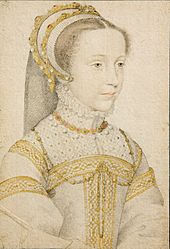
In December 1552, Mary of Austria, sister of Emperor Charles V, told Mary that her complaints had no power and must come from Arran. Mary's power was growing. In May 1553, it was heard that she had challenged Arran's regency. Mary herself became regent on 12 April 1554. Henri Cleutin is said to have placed the crown on her head. The eleven-year-old Queen Mary sent her congratulations to "the Queen, my mother" from France.
Mary of Guise often asked her brothers in France for advice. They held important government jobs in France. This meant Scotland and France worked together as allies. During her regency (1554–60), Frenchmen were put in charge of the treasury and the Great Seal of Scotland. The French ambassador sometimes attended the Scottish Privy Council. While Cleutin was popular, Scottish nobles were unhappy about these French appointments. This unhappiness led to future problems.
Mary quickly began to handle Scottish affairs well. In July 1554, she traveled to Jedburgh to hold a court session for two weeks. She hoped to stop the long-running fights between the Scott and Kerr clans. She was escorted by armed horsemen. In the autumn, she paid for a ship, troops, and a cannon to help the Earl of Sutherland arrest Iye du Mackay, who was causing trouble. However, the Earls of Huntly and Argyll were less successful in other areas. Huntly's failure led to his imprisonment. In 1556, she visited Inverness, Elgin, and Aberdeen. These efforts were interrupted by a war in January 1557. In October, Mary went to Hume Castle and sent an army towards England. But the Scottish lords refused to cross the border and went home.
Trouble with Protestants
Mary's rule was threatened by the growing power of Scottish Protestants. At first, she had allowed Protestant preachers to spread their ideas. She needed their support for her pro-French policies. Also, they could not get help from England because Catholic Mary I ruled there. The marriage of Mary, Queen of Scots, to the French dauphin on 24 April 1558 was soon followed by the death of Mary I of England. Elizabeth I became Queen of England on 17 November 1558. Mary, Queen of Scots, had a claim to the English throne. If the King of France wanted to push Mary's claim, he needed Scotland to be a strong Catholic country. Some historians believe Mary of Guise's policy did not change much, but both Catholics and Protestants reacted strongly to the tense situation. When the Scottish Reformation crisis grew, King Henry II of France died in July 1559. Mary, Queen of Scots, became Queen Consort of France. In France, Mary and Francis II began to use the English royal symbols on their coats of arms. This also made England want to get involved in Scottish affairs.
In 1557, a group of Scottish lords, known as the "Lords of the Congregation," made a promise to support the "Word of God and his Congregation." This led to attacks on religious statues and buildings in 1558-1559. At the same time, plans were made for a Reformed way of worship. In 1558, the Regent called the Protestant preachers to explain their teachings. But she backed down when lords from the west threatened to revolt.
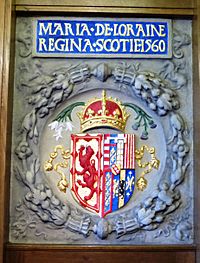
When the Protestant Elizabeth became Queen of England in 1558, it gave hope and fear to Scottish Protestants. Elizabeth secretly supported the Lords of the Congregation. In January 1559, a paper called the Beggars' Summons threatened to remove friars (religious brothers) and replace them with beggars. This was meant to appeal to townspeople who had complaints against friars. Fearing disorder, Mary of Guise decided to be less tolerant. She called the reformed preachers to appear before her in Stirling on 10 May. A rebellion followed. Men from Angus gathered in Dundee to go with the preachers to Stirling. On 4 May, they were joined by John Knox, who had just arrived from France. Knox's sermons in Perth and Dundee stirred up the crowd, who then attacked religious houses. In response, the Regent marched on Perth. But she had to retreat and negotiate when another group of reformers arrived.
Among the Regent's representatives were the Earl of Argyll and Lord James Stewart, both Protestants. When the Regent placed French soldiers in Perth, both of them left her and joined the Lords of the Congregation. John Knox also joined them. Even Edinburgh fell to them in July, and Mary retreated to Dunbar Castle. The Lords of the Congregation made a truce with Mary of Guise. They signed the Articles of Leith on 25 July 1559, which promised religious tolerance. Then they went back to Stirling.
In September, the former regent, the Earl of Arran, joined the Lords of the Congregation and set up a temporary government. However, Mary of Guise received more French soldiers. Some of these troops settled in Kinghorn in Fife. After they destroyed a house, Mary reportedly said, "Where is now John Knox's God? My God is now stronger than his, yes, even in Fife." In November, the rebels were pushed back to Stirling. Fighting continued in Fife. All seemed lost for the Protestants until an English fleet arrived in January 1560. This caused the French to retreat to Leith.
Talks with England then began. John Knox was not included because of his earlier writing against female rulers. The resulting Treaty of Berwick in February was an agreement between the Earl of Arran and the English to work together to remove the French. As a result, Queen Elizabeth I sent an English army into Scotland to help their Scottish allies surround the French in Leith. As the fighting continued, the English ambassador in France praised Mary of Guise for having the "heart of a man of war."
Mary's Death
After an English attack on Leith was pushed back with many losses, some of the Lords of the Congregation came to Edinburgh Castle on 12 May 1560. They had dinner with Mary and the castle keeper. They talked about a plan for Mary to travel to France and meet Elizabeth in England. Her brother would have been made a viceroy in Scotland. The Lords again complained about Frenchmen being given Scottish government jobs. Talks to end the siege of Leith continued. But the next day, the talks ended when the French commanders in Leith were not allowed to come to the castle to discuss the plans with Mary.
While still making Edinburgh Castle stronger, Mary became very ill. Over the next eight days, her mind began to wander, and sometimes she could not even speak. On 8 June, she made her will. She died from a condition called dropsy (swelling caused by fluid buildup) on 11 June 1560.
Her body lay in state in the castle for some time, wrapped in cloth and covered with a white sheet. Her ladies-in-waiting attended her. Her body was then wrapped in lead and placed in a coffin in St Margaret's Chapel in Edinburgh Castle for several months. The chapel was decorated with black cloth. On 18 March 1561, her body was secretly carried from the castle at midnight and shipped to France. Mary, Queen of Scots, attended her funeral in France in July 1561. Mary of Guise was buried at a church in Reims, where her sister was the head nun. A marble tomb with a bronze statue of Mary was built. This tomb was destroyed during the French Revolution. Out of Mary's five children, only her daughter Mary, Queen of Scots, lived longer than her.
Some people have wondered if Mary was poisoned, perhaps by order of Queen Elizabeth I. However, there is no proof for these claims. An autopsy was done the day after she died. Mary's death was clearly from natural causes. She herself complained in April that her legs were swelling, and she thought she had dropsy. Even her enemy, John Knox, wrote that in May, "began hir bellie and lothsome leggis to swell." In the 1500s, many royal deaths were suspected to be murders. But none of Mary's contemporaries thought she died unfairly.
The Regent's death led to the Treaty of Edinburgh. In this treaty, France and England agreed to remove their soldiers from Scotland. The French offered the Scots some agreements from King Francis and Queen Mary, including the right to call a parliament. The treaty meant that power in Scotland went to the pro-English Protestants.
Mary's Household
Records of Mary's expenses and household list her ladies-in-waiting. These included married women like Lady Arran and Lady Erskine. The unmarried women included Margaret Hume and Jean Elphinston.
Her household also had a female fool or jester named Serat, who wore a red-and-yellow gown. Jane, a dwarf, wore light-purple velvet.
Mary's Legacy
Most historians have a good opinion of Mary of Guise, except for her strong enemy, John Knox. Historian Rosalind K. Marshall says that Mary's biographers have all praised her intelligence and strength. Marshall writes that Mary of Guise "sacrificing her own comfort, interests, and ultimately her life, Mary of Guise had fought a long, desperate, and, in the end, hopeless struggle to preserve Scotland as a pro-French, Roman Catholic nation for her daughter." She adds that Mary was "charming, highly intelligent, and hard-working, with a diplomatic manner and an ability to fight on regardless of hostility, disappointment, and ill health." Mary was never just a puppet of the French king.
Mary in Stories and Films
- Mary of Guise is the main character in the book The Five Year Queen by Janet Walkinshaw.
- She appears in several books of the Lymond Chronicles by Dorothy Dunnett. Her visit to France in 1550 is shown in the second book, Queens' Play.
- In the 1998 movie Elizabeth, Mary was played by French actress Fanny Ardant. Her death was shown as an assassination in the film.
- In The CW TV series Reign, Amy Brenneman plays Marie de Guise.
Images for kids
See also
 In Spanish: María de Guisa para niños
In Spanish: María de Guisa para niños


